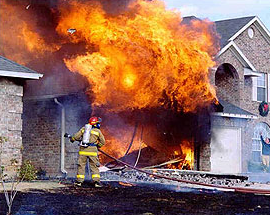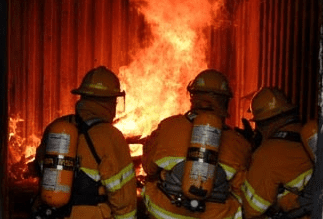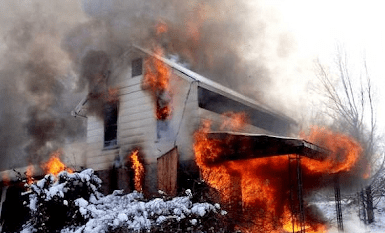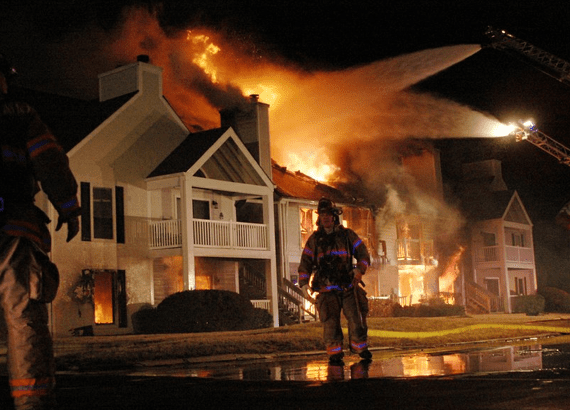 I was recently contacted by email from a Situational Awareness Matters member asking if aggressiveness and safety can co-exist at an emergency scene. My answer was “of course they can.” The two actions, being safe and being aggressive are not mutually exclusive. To think they are is to believe responders must sacrifice safety when they choose to be aggressive. Or that when responders choose to do things safely, they can no longer be aggressive. I believe safety and aggressiveness can be accomplished simultaneously. Here’s how…
I was recently contacted by email from a Situational Awareness Matters member asking if aggressiveness and safety can co-exist at an emergency scene. My answer was “of course they can.” The two actions, being safe and being aggressive are not mutually exclusive. To think they are is to believe responders must sacrifice safety when they choose to be aggressive. Or that when responders choose to do things safely, they can no longer be aggressive. I believe safety and aggressiveness can be accomplished simultaneously. Here’s how…
Defining aggressive
There are several definitions of aggressive and, perhaps in the mind of the responder, several actions that demonstrate aggressive tactics. Sometimes the best way to understand the meaning of a word is to look at its synonyms – other words that mean the same thing. Three of the synonyms for aggressive are: Assertive, determined, and hard-hitting. All three of these words define the essence of a quality first responder – someone who does not shy away from the task at hand even if the task is dangerous.
 Other synonyms for aggressive, however, may not be as endearing or as desired. Hostile, destructive and uncompromising are among them. Most would agree that hostile and destructive are not qualities desired of first responders. But what about uncompromising? Shouldn’t that word be in the first list – the list of essential qualities of first responders? While some may argue it should, I content it should not.
Other synonyms for aggressive, however, may not be as endearing or as desired. Hostile, destructive and uncompromising are among them. Most would agree that hostile and destructive are not qualities desired of first responders. But what about uncompromising? Shouldn’t that word be in the first list – the list of essential qualities of first responders? While some may argue it should, I content it should not.
To compromise means to come to terms with something or someone. In the case of a fire, it would mean coming to terms with the conditions being faced and making a determination as to whether aggressive tactics can change the outcome. Some might call this conducting a risk assessment. What we need to come to terms with is the fact that we are not always in a position to change the outcome. If we are uncompromising, it means we are not willing to come to terms with the fact that the fire is going to “win” and we are going to “lose” and the victim is going to die.
The savable life
 The primary goal of a first responder is to save lives. We train hard for the opportunity and when given the chance, we’re going to give it our all to achieve that goal. But is every life savable? The answer is no. Doctors know this. Like first responders, the goal of a doctor is also to save lives. However, sometimes the patients that doctors care for are not savable. By disease or trauma, the patient has a condition that is incompatible with life. In the case of a traumatic cardiac arrest, the code is not worked because doctors know the systemic trauma is not compatible with life. In the case of disease, the patient is encouraged to sign DNR (Do Not Resuscitate) orders so that no heroic efforts will be made when the time comes to transition from life to death.
The primary goal of a first responder is to save lives. We train hard for the opportunity and when given the chance, we’re going to give it our all to achieve that goal. But is every life savable? The answer is no. Doctors know this. Like first responders, the goal of a doctor is also to save lives. However, sometimes the patients that doctors care for are not savable. By disease or trauma, the patient has a condition that is incompatible with life. In the case of a traumatic cardiac arrest, the code is not worked because doctors know the systemic trauma is not compatible with life. In the case of disease, the patient is encouraged to sign DNR (Do Not Resuscitate) orders so that no heroic efforts will be made when the time comes to transition from life to death.
The emotions of death
No one wants to stand by and let another human die, especially first responders. It runs completely counter to our training and our oath. Like first responders, many family members also struggle with the life-to-death transitional period. Under stress, some want to invalidate the DNR order and compel responders to take aggressive life-saving measures. And even if responders did abide by those wishes, the outcome is going to be the same, if only delayed a short time.
 First responders who arrive at emergency scenes can be gripped by the same emotions. In the case of a fire, the clues and cues may indicate the interior conditions are not compatible with life. In fact, the hostile interior conditions could (and sadly do) take the life of first responders, enveloped in their full protective gear. If first responders cannot survive in such conditions, it is entirely implausible that a civilian – whose skin is destroyed when exposed to temperatures exceeding 162 degrees fahrenheit (72 degrees Celsius)1 – is going to survive. But we want to give them every chance for survival because we’re trained to rescue, not to stand there and watch them die.
First responders who arrive at emergency scenes can be gripped by the same emotions. In the case of a fire, the clues and cues may indicate the interior conditions are not compatible with life. In fact, the hostile interior conditions could (and sadly do) take the life of first responders, enveloped in their full protective gear. If first responders cannot survive in such conditions, it is entirely implausible that a civilian – whose skin is destroyed when exposed to temperatures exceeding 162 degrees fahrenheit (72 degrees Celsius)1 – is going to survive. But we want to give them every chance for survival because we’re trained to rescue, not to stand there and watch them die.
1National Institute of Standards and Technology. http://www.nist.gov/fire/fire_behavior.cfm
The situational awareness tie-in
Thanks for sticking with me as I had to set down a few foundational points before talking about how aggressive tactics may impede situational awareness. When a responder is of the mindset that all lives are savable, then there is only one tactical mindset – aggressive-offensive. Get inside and “save” the life. Once the mind is made up, it can be extremely difficult to change it, even in the presence of very convincing evidence that the action plan is beyond all reasonable expectation of safety. Safety goes out the window – we have a life to save!
 And when all concerns for personal safety go out the window, so can all processes relating to developing and maintaining situational awareness. The clues and cues indicating the victim is in a non-survivable environment… are present. The clues and cues indicating the structural integrity is compromised… are present. The clues and cues indicating the fire is preparing to flashover… are present. And the clues and cues indicating the victim is in an environment incompatible with life… are present.
And when all concerns for personal safety go out the window, so can all processes relating to developing and maintaining situational awareness. The clues and cues indicating the victim is in a non-survivable environment… are present. The clues and cues indicating the structural integrity is compromised… are present. The clues and cues indicating the fire is preparing to flashover… are present. And the clues and cues indicating the victim is in an environment incompatible with life… are present.
And despite the presence of overt clues and cues (e.g., tell-tale indicators), the first responders do what they always do. They make entry and aggressively search for the victim. In this scenario, the responders have not ASSUMED the risk of the incident. They have CREATED the risk of the incident by putting themselves in a bad situation. Why would they do that?
Most first responders don’t know any better because they’ve never been trained to do anything but aggressive interior search techniques. No one has ever had the conversation with them about what “no-go” looks like and under what conditions they should not enter even if there is a victim inside. They arrive with a single goal – search and rescue. And no amount of evidence presented is going to sway them from their mission. Because we’re firefighters. That’s what we do.
Chief Gasaway’s Advice
 I am a strong proponent of aggressive tactics when applied in the right measure, at the right time, under the right conditions. That means a lot of things have to be “right” for aggressive tactics to make sense (and be safe). What helps determine if the conditions are “right” is situational awareness. This includes not making any pre-determination that any time there is a victim inside a burning building crews are going to enter and conduct a search.
I am a strong proponent of aggressive tactics when applied in the right measure, at the right time, under the right conditions. That means a lot of things have to be “right” for aggressive tactics to make sense (and be safe). What helps determine if the conditions are “right” is situational awareness. This includes not making any pre-determination that any time there is a victim inside a burning building crews are going to enter and conduct a search.
The safety of personnel is rooted in situational awareness. Capturing clues and cues. Making sense of what those clues and cues mean in the context of time and the current conditions. Making accurate predictions about future outcomes based on the current (and changing) conditions.
For example, the clues and cues a first responder might use to determine of an aggressive interior search is viable include:
- Building construction and decomposition: What is the building made out of? How much of the structural components have decomposed? Where is the building at in the process of falling down?
- Fire and smoke conditions: Each provide a separate set of clues and cues. What is the color, volume, velocity and density of the smoke? What does it mean? What is the color, volume, velocity and density of the fire? What does that mean?
- Speed of the incident: Stated another way – speed of change. A fire scene is a dynamically changing environment. Many times, if you know what to look for, there are subtle (and not so subtle) clues and cues that indicate how fast conditions are changing. Knowing what to look for and then spending some time watching the incident to understand the speed of change can provide valuable information.
- Resource assessment: In order to effectively carry out a rescue mission – assuming all the conditions based on an assessment of the factors listed above are within the acceptable range – requires resources. Namely personnel, apparatus, equipment and water. During training evolutions we go to painstaking efforts to ensure we have the right resources in place before we practice rescue evolutions. However, it would be rare for a real rescue incident to provide the same resources present during training. It is vital to assess the quantity and quality of resources to ensure the aggressive search tactics can achieve the desired results.
Action Items
 1. Discuss what “go” and “no go” conditions look like as it relates to building construction, smoke and fire conditions, the speed of the incident, and resource assessments.
1. Discuss what “go” and “no go” conditions look like as it relates to building construction, smoke and fire conditions, the speed of the incident, and resource assessments.
2. Engage in a rational discussion about the conditions it would be acceptable not to engage in aggressive interior search (and the conditions in which it would not be). It is particularly important to have this discussion in the calm, non-emotional environment of the training room or around the coffee table. Once you’re at the emergency scene, emotions and the drive to save a life is going to impact rational thought.
3. Discuss the clues and cues that would indicate there may be a savable life as well as the clues and cues that indicate there is not. This is a very important discussion to have because, during training, when you’re practicing search and rescue, the conditions are always right and you always go and and you always rescue the victim and you never find yourself in an environment you should not have been in to begin with.
The conditions of real-life rescues will rarely align with the controlled conditions in which the training was conducted. But if the mindset is “go” (because that’s what you always do in training), you’re going to go… regardless of the clues and cues that indicate otherwise. You’re making entry with flawed situational awareness.
_____________________________________________________
If you are interested in taking your understanding of situational awareness and high-risk decision making to a higher level, check out the Situational Awareness Matters Online Academy.
CLICK HERE for details, enrollment options and pricing.
__________________________________
Share your comments on this article in the “Leave a Reply” box below. If you want to send me incident pictures, videos or have an idea you’d like me to research and write about, contact me. I really enjoy getting feedback and supportive messages from fellow first responders. It gives me the energy to work harder for you.
Thanks,
Email: Support@RichGasaway.com
Phone: 612-548-4424
www.SAMatters.com/
www.SAMatters.com/academy/
Facebook Fan Page: www.facebook.com/SAMatters
Twitter: @SAMatters
LinkedIn: Rich Gasaway
YouTube: SAMattersTV
iTunes: SAMatters Radio



Right on Chief! Read the building, Read the Smoke, Read the Fire, Read the Firefighters & Measure the risk.
RIGHT ON, RICH.
This article is going to be required reading for all of our officers and discussed with all staff at upcoming training. We have been successful in changing our culture from “always a green light for interior offensive operations unless a red light stops us” to “always a red light for interior offensive operations until an analysis of the situation turns the lights green”. It is a subtle change but so necessary with new construction methods and heightened fuel loads today.
Thanks for a great website.
Chief Bob Kissner
Kingsville, Ontario, Canada.
Chief Kissner,
Thank you for posting your feedback on this article. I love having the international perspectives being shared on the site. We are all benefit when we share. I like your approach to the “go” or “no go” decision making. Encourage your members, in training, to talk about what the clues and cues are that would make the light red or green, or change it from green to red. Good stuff!
Rich
Great read Chief… Only problem is the 5 drills that come to mind to write….
Lance,
Thanks for the feedback. I’ve seen your creating at work. I doubt coming up with drill topics will be a challenge for you. Maybe limiting it to five will be.
Rich
Hey Rich,
After 42 years, the last 20 of which were devoted to a simple mantra “everyone goes home” . I find myself more and more realising that tachisphychia is less about “why are you taking so much time” than “you have little time to make a difference”; but be assured, I know with those few moments you gave I will not judge because I was not there. I do not know all of the circumstances, and I know you did your best. I only hope that when I wrote the SOP, when I gave the training, I didn’t let you down…..!
Hey Rich:
Enjoyed your article. I started laughing when I read your comment at first about not trying to bully a fire. But then realized our culture is not always go aggressively but to do so professionally drawing on education, experience and risk vs reward. As you say Situational Awareness.
I was put in the position of defending a fire Dept that did not risk by pumping water when there was nothing to gain. I fully supported the no go. Nothing to save. No exposures. Building already down. Good call on the no go. Not understood by non fire service professionals.